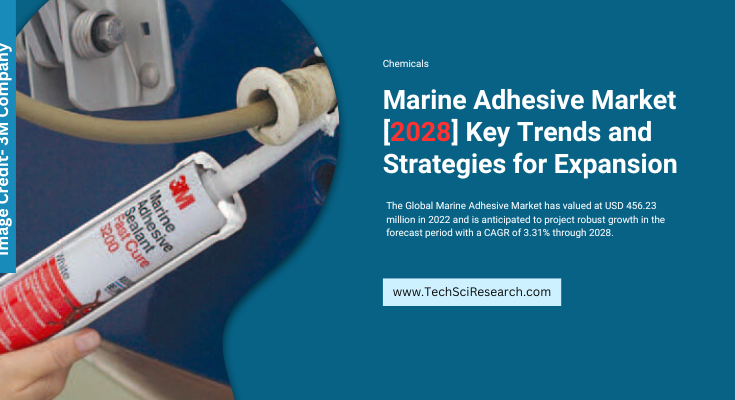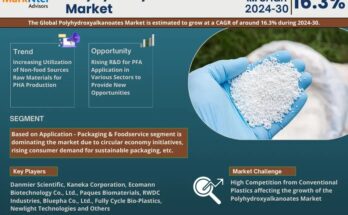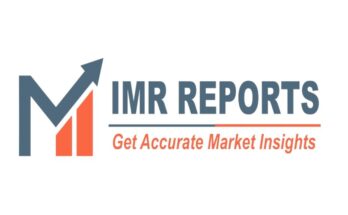According to TechSci Research report, “Marine Adhesive Market – Global Industry Size, Share, Trends, Competition Forecast & Opportunities, 2028”, the Global Marine Adhesive Market has valued at USD 456.23 million in 2022 and is anticipated to project robust growth in the forecast period with a CAGR of 3.31% through 2028. Technological advancements have been a driving force behind the growth of the global Marine Adhesive market.
These specialized adhesives, designed for use in the marine industry, have witnessed significant development and expansion due to continuous innovation in manufacturing processes, materials, and applications. These advancements have not only improved the performance and durability of marine adhesives but have also contributed to the sustainability and efficiency of marine operations. One of the primary areas where technology has had a profound impact is in the formulation of advanced adhesive materials.
Traditional marine adhesives were often based on solvent-based formulations, which posed environmental and health concerns. However, recent developments have led to the creation of water-based and solvent-free adhesives that are not only more environmentally friendly but also offer superior bonding characteristics.
These advanced formulations provide excellent adhesion to a wide range of substrates commonly found in marine applications, including metals, plastics, fiberglass, and composites. Furthermore, the evolution of nanotechnology has paved the way for the development of nanocomposite marine adhesives. These adhesives incorporate nanoscale particles, such as nanoclays or nanofillers, into the adhesive matrix.
The addition of nanoparticles enhances the adhesives’ mechanical properties, resistance to environmental factors like salt water and UV radiation, and overall performance. Nanocomposite marine adhesives have become indispensable in shipbuilding, where lightweight and high-strength materials are crucial for improving vessel efficiency and reducing fuel consumption.
The application of marine adhesives in structural bonding and repair has also seen remarkable technological advancements. New adhesive systems offer rapid cure times, enabling quicker vessel repairs and maintenance. Advanced adhesives, such as one-component heat-cured systems and UV-curable adhesives, are replacing traditional welding and mechanical fastening methods in many marine applications. These innovations result in reduced downtime, improved structural integrity, and cost savings for shipowners and operators. Additionally, technological progress has led to the development of smart adhesives with enhanced functionalities. These adhesives can exhibit self-healing properties, which can be particularly valuable in marine applications where maintaining the integrity of seals and joints is critical for safety and performance. Smart adhesives can also incorporate sensors and monitoring capabilities, allowing real-time data collection on the condition of bonded structures. This facilitates predictive maintenance and helps prevent costly failures in marine systems.
The digitalization of manufacturing processes has further contributed to the growth of the global Marine Adhesive market. Computer-aided design (CAD) and simulation software enable engineers and designers to optimize adhesive bonding layouts, predict adhesive behavior under different conditions, and reduce the need for physical prototypes. Digital twin technology allows for real-time monitoring and analysis of adhesive-bonded structures, ensuring their integrity and safety throughout their operational life. Sustainability is another critical aspect where technology plays a pivotal role in the marine adhesive industry. Innovative recycling and waste reduction methods have been developed to address environmental concerns. Closed-loop recycling processes enable the recovery and reuse of adhesive materials from end-of-life marine components, reducing waste and conserving resources. Moreover, the development of bio-based marine adhesives, derived from renewable sources, aligns with global sustainability goals and regulations, making the marine industry more eco-friendly.
In conclusion, technological advancements have been instrumental in driving the growth of the global Marine Adhesive market. From advanced adhesive formulations to nanocomposites, smart adhesives, and digitalization, innovation has expanded the applications and improved the performance of marine adhesives. Sustainability efforts, including recycling and bio-based solutions, are also contributing to the industry’s evolution. As the maritime industry continues to prioritize efficiency, safety, and environmental responsibility, ongoing technological advancements in marine adhesives are expected to remain at the forefront, providing solutions that enhance vessel performance, durability, and sustainability on a global scale.
Browse over XX market data Figures spread through XX Pages and an in-depth TOC on “Global Marine Adhesive Market” @ https://www.techsciresearch.com/report/marine-adhesive-market/19150.html
The Global Marine Adhesive Market is segmented into resin type, application, substrate, end user, regional distribution, and company. Based on the resin type, the epoxy segment emerged as the dominant player in the global market for Marine adhesives. Epoxy adhesives are renowned for their exceptional bonding strength, which is vital in the marine industry where the integrity of bonded joints is critical for safety and structural stability. Epoxy adhesives offer versatility in terms of substrates they can bond, including metals, composites, plastics, and wood. This versatility makes them suitable for various marine applications, from boat construction to ship repairs.
Epoxy adhesives are known for their resilience in harsh marine environments, including exposure to saltwater, UV radiation, and temperature variations. They maintain their bond strength and structural integrity under these challenging conditions. Epoxy adhesives can cure and bond effectively even when applied underwater, making them invaluable for marine repairs and maintenance tasks below the waterline. SBC adhesives can be formulated to be either hydrophobic or hydrophilic, depending on the The Asia-Pacific (APAC) region has emerged as the dominant player in the marine Adhesive Market, surpassing both Europe and North America. This growth can be attributed to the robust economic development and the simultaneous expansion of population in countries such as China and India. These factors are expected to drive increased spending on marine-related activities throughout Asia Pacific over the next seven years. Furthermore, according to projections from Oxford Economics, the volume of marine output is forecasted to experience an impressive 85.0% growth, reaching a total of USD 17.5 trillion by the year 2030. China and India are set to play a pivotal role in propelling the marine industry forward in this region.
Europe is another region that is experiencing growth during the projected period. This growth is primarily attributed to the significant presence of European ship owners who control approximately 40.0% of the world’s shipping fleet. Europe boasts an extensive network of inland waterways, particularly in countries situated in Central Europe such as France, Germany, Russia, and Belgium. The ongoing development and increasing importance of these inland waterways for trade and passenger transportation are expected to stimulate demand for marine adhesives within the European market.
Major companies operating in the Global Marine Adhesive Market are:
- 3M Company
- Bostik SA
- Gurit AG
- H.B. Fuller Company
- Henkel AG & Co. KGaA
- Huntsman International LLC (Huntsman Corporation)
- Illinois Tool Works
- Parson Adhesives Inc.
- Scott Bader Company Ltd.
- Sika AG
Download Free Sample Report @ https://www.techsciresearch.com/sample-report.aspx?cid=19150
Customers can also request for 10% free customization on this report
“The global Marine Adhesive market is witnessing substantial growth due to increasing demand across various marine applications. Marine adhesives play a critical role in bonding and sealing components in ships, boats, and offshore structures, offering excellent resistance to harsh maritime conditions.
The market’s growth can be attributed to several factors, including the rising need for lightweight and fuel-efficient vessels, stringent regulations for reducing emissions and improving fuel efficiency, and the expansion of the global maritime industry. Technological advancements have led to the development of high-performance marine adhesives that offer superior bonding strength, durability, and resistance to saltwater, UV radiation, and temperature fluctuations.
Additionally, the increasing adoption of composites in shipbuilding and repairs has driven the demand for specialized marine adhesives tailored to these materials. As the marine industry continues to evolve, focusing on eco-friendly solutions and innovative materials, the global Marine Adhesive market is expected to see sustained growth in the coming years, offering solutions that enhance the safety and performance of marine vessels and structures,” said Mr. Karan Chechi, Research Director with TechSci Research, a research-based management consulting firm.
“Marine Adhesive Market- Global Industry Size, Share, Trends, Opportunity, and Forecast, 2018-2028 Segmented by Resin Type (Epoxy, Silicon, Polyurethane, Acrylic, and Other), By Application (Deck Systems, Glazing, Panel Bonding, and Others), By Substrate (Plastic, Composite, Metals, and Others), By End Use (Cargo Ships, Passenger ships, Boat, and Other), By Region and competition”, has evaluated the future growth potential of Global Marine Adhesive Market and provides statistics & information on market size, structure and future market growth. The report intends to provide cutting-edge market intelligence and help decision makers take sound investment decisions. Besides, the report also identifies and analyzes the emerging trends along with essential drivers, challenges, and opportunities in the Global Marine Adhesive Market.
You may also read:
Polyester Hot Melt Adhesives Market [2028] Analysis, Dynamics, and Key Players.
Dental Adhesives and Sealants Market Value, Trends [2028], Economy, Expansion, Leader
Dehydrating Breather Market Analysis, Development [2028], Key Terms
Construction Additives Market [2028] – Analysis, Trends, & Insights
Transparent Conductive Films Market – A Comprehensive Report [2028]
Personal Care Ingredients Market [2028] Exploring Potential, Growth, Future & Trends
Table of Content-Marine Adhesive Market
- Product Overview
1.1. Market Definition
1.2. Scope of the Market
1.2.1. Markets Covered
1.2.2. Years Considered for Study
1.2.3. Key Market Segmentations
- Research Methodology
2.1. Objective of the Study
2.2. Baseline Methodology
2.3. Key Industry Partners
2.4. Major Association and Secondary Applications
2.5. Forecasting Methodology
2.6. Data Triangulation & Validation
2.7. Assumptions and Limitations
- Executive Summary
3.1. Overview of the Market
3.2. Overview of Key Market Segmentations
3.3. Overview of Key Market Players
3.4. Overview of Key Regions/Countries
3.5. Overview of Market Drivers, Challenges, Trends
- Impact of COVID-19 on Global Marine Adhesive Market
- Voice of Customer
- Global Marine Adhesive Market Outlook
6.1. Market Size & Forecast
6.1.1. By Value & Volume
6.2. Market Share & Forecast
6.2.1. By Resin Type (Epoxy, Silicon, Polyurethane, Acrylic, and Other)
6.2.2. By Application (Deck Systems, Glazing, Panel Bonding, and Others)
6.2.3. By Substrate (Plastic, Composite, Metals, and Others)
6.2.4. By End Use (Cargo Ships, Passenger ships, Boat, and Other)
6.2.5. By Region
6.2.6. By Company (2022)
6.3. Market Map
- Asia Pacific Marine Adhesive Market Outlook
7.1. Market Size & Forecast
7.1.1. By Value & Volume
7.2. Market Share & Forecast
7.2.1. By Resin Type
7.2.2. By Application
7.2.3. By Substrate
7.2.4. By End User
7.2.5. By Country
7.3. Asia Pacific: Country Analysis
7.3.1. China Marine Adhesive Market Outlook
7.3.1.1. Market Size & Forecast
7.3.1.1.1. By Value & Volume
7.3.1.2. Market Share & Forecast
7.3.1.2.1. By Resin Type
7.3.1.2.2. By Application
7.3.1.2.3. By Substrate
7.3.1.2.4. By End User
7.3.2. India Marine Adhesive Market Outlook
7.3.2.1. Market Size & Forecast
7.3.2.1.1. By Value & Volume
7.3.2.2. Market Share & Forecast
7.3.2.2.1. By Resin Type
7.3.2.2.2. By Application
7.3.2.2.3. By Substrate
7.3.2.2.4. By End User




